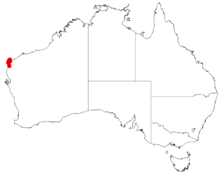Acacia alexandri
| Acacia alexandri | |
|---|---|
| Scientific classification | |
| Kingdom: | Plantae |
| Clade: | Tracheophytes |
| Clade: | Angiosperms |
| Clade: | Eudicots |
| Clade: | Rosids |
| Order: | Fabales |
| Family: | Fabaceae |
| Subfamily: | Caesalpinioideae |
| Clade: | Mimosoid clade |
| Genus: | Acacia |
| Species: | A. alexandri
|
| Binomial name | |
| Acacia alexandri | |

| |
| Occurrence data from AVH | |
Acacia alexandri is a shrub belonging to the genus Acacia and the subgenus Phyllodineae native to north western Australia.
Description[edit]
The open and wispy shrub typically grows to a height of 1.5 to 3 metres (5 to 10 ft).[1] It has slender branchlets with spinose stipules that are 3 to 4 mm (0.12 to 0.16 in) that are not common on mature plants. The linear evergreen phyllodes have a length of 6 to 13 cm (2.4 to 5.1 in) and a width of 2.5 to 6 mm (0.098 to 0.236 in) with a single prominent nerve.[2] It blooms from August to September and produces cream flowers.[1]
Taxonomy[edit]
The species was first formally described by Bruce Maslin in 1992 as part of the work Acacia Miscellany. Review of Acacia victoriae and related species (Leguminosae: Mimosoideae: Section Phyllodineae) as published in the journal Nuytsia. The only synonym is Racosperma alexandri as described by Leslie Pedley in 2003.[3]
Distribution[edit]
It is native to a small area in the Gascoyne region of Western Australia[1] around Cape Range where it is found on rocky limestone hillsides as part of mallee shrubland communities growing in rocky pink loamy soils.[2]
See also[edit]
References[edit]
- ^ a b c "Acacia alexandri". FloraBase. Western Australian Government Department of Biodiversity, Conservation and Attractions.
- ^ a b "Acacia alexandri". World Wide Wattle. Western Australian Herbarium. Retrieved 2 March 2019.
- ^ "Acacia alexandri Maslin". Atlas of Living Australia. Global Biodiversity Information Facility. Retrieved 2 March 2019.

